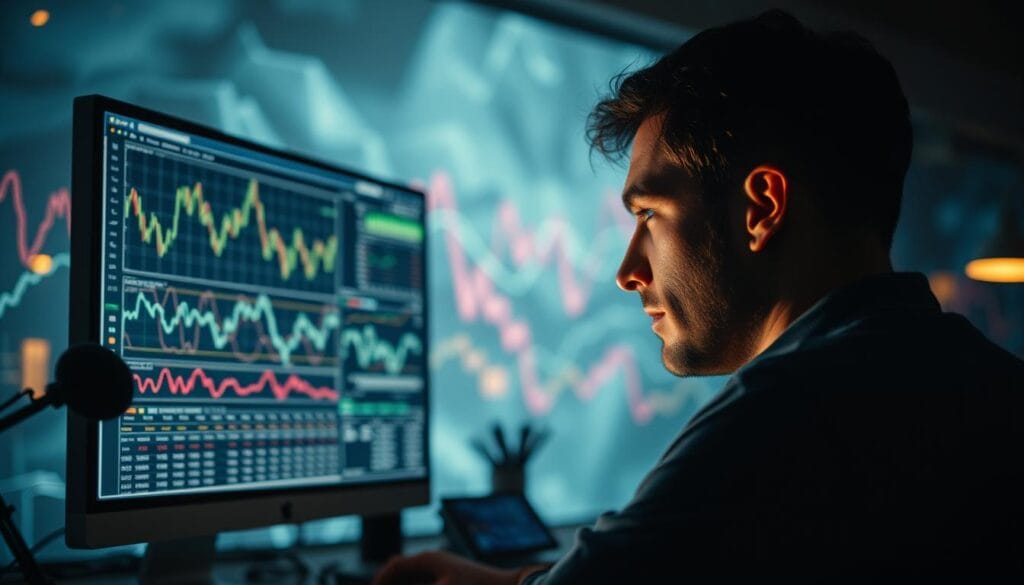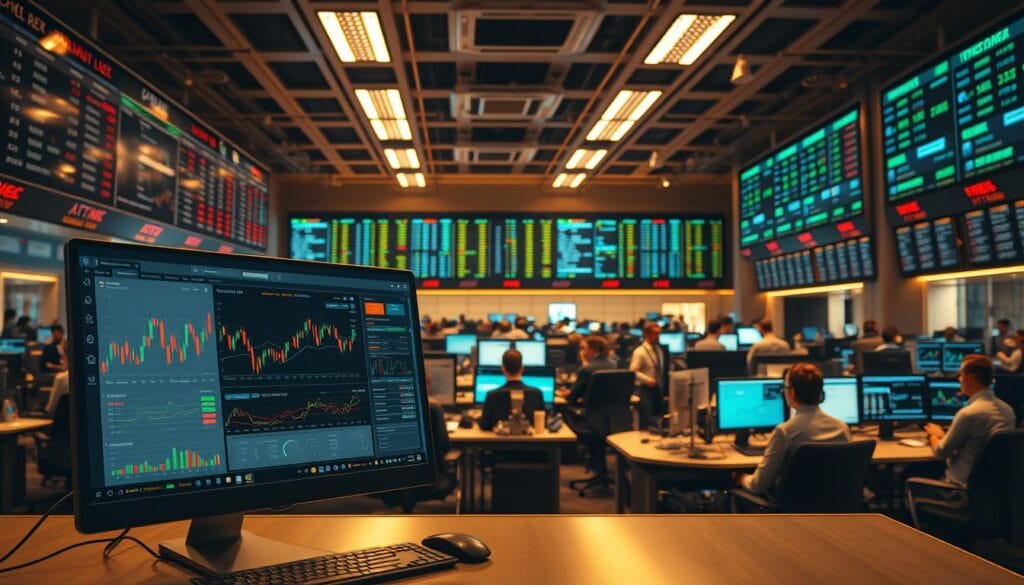Over 90% of daily transactions on major U.S. exchanges now occur without human intervention. This seismic shift reflects the growing influence of automated decision-making systems in global finance. Institutions like JPMorgan have reported a 35% improvement in trade execution efficiency since deploying tools such as their LOXM platform, which processes millions of data points in milliseconds.
What began as institutional technology now empowers individual investors through platforms like 3Commas. These systems analyze historical patterns and real-time indicators to identify opportunities invisible to traditional methods. Renaissance Technologies’ Medallion Fund demonstrates this capability, achieving consistent returns through machine-driven strategies that adapt to evolving conditions.
The fusion of computational power and financial expertise creates unprecedented precision in capital allocation. This article examines how predictive analytics reshape investment approaches, balancing technical sophistication with practical implementation. Subsequent sections will explore ethical considerations, risk management frameworks, and emerging regulatory challenges in this rapidly evolving landscape.
Key Takeaways
- Automated systems now dominate transaction volumes across major exchanges
- Machine learning enables analysis of complex, multi-layered datasets
- Advanced platforms bridge the gap between institutional and retail investors
- Real-time adaptation to market changes drives competitive advantage
- Successful implementation requires balancing innovation with oversight
Understanding the AI Revolution in Trading

Financial markets witnessed a silent transformation as computational methods began processing decades of price data in minutes. This shift started with hedge funds in the early 2010s, where quantitative analysts combined statistical models with growing computing power. By 2020, cloud infrastructure enabled real-time analysis of global news, social sentiment, and macroeconomic indicators.
The Emergence of Advanced Analytics in Finance
Three machine learning approaches now drive modern systems. Supervised models predict price movements using historical patterns, while unsupervised techniques uncover hidden correlations across assets. Reinforcement learning allows systems to adapt strategies through simulated market environments. Platforms like Trade Ideas employ these methods to scan 10,000+ securities simultaneously, identifying opportunities human analysts might overlook.
Transformative Shifts from Conventional Approaches
Traditional methods relied on static rules and periodic adjustments. Today’s systems dynamically update parameters using live data streams. A 2024 JPMorgan study revealed adaptive tools reduced latency by 47% compared to manual execution. Retail platforms such as 3Commas now offer features once exclusive to institutions, leveling the playing field through machine learning techniques.
Key differentiators include emotion-free decision-making and multi-layer risk assessment. Where human traders might hesitate during volatility, automated systems execute predefined protocols instantly. This evolution demands new skill sets – successful market participants now combine financial expertise with data literacy to harness these powerful tools effectively.
Overview of AI Stock Trading Algorithms 2025

Modern trading ecosystems now rely on self-optimizing systems that recalibrate strategies faster than traditional models ever could. These frameworks process terabytes of market data—from order flow imbalances to geopolitical shifts—adjusting positions milliseconds before trends materialize. A 2024 MIT Sloan study found adaptive models improved price prediction accuracy by 62% compared to static systems from earlier decades.
Key Innovations Defining 2025
Three breakthroughs dominate current implementations. Multi-asset correlation engines identify hidden relationships between equities, currencies, and digital assets, enabling cross-market arbitrage. Sentiment-driven execution tools analyze news cycles and social media chatter, adjusting trade sizes based on volatility forecasts. Platforms like E*TRADE now deploy these methods, reducing slippage by 28% in recent backtests.
Impact on Market Trends and Trading Volumes
Volatility-adjusted strategies have increased daily equity rotations by 19% across NASDAQ-listed securities since 2023. “Systems now forecast liquidity shifts eight hours in advance,” notes Goldman Sachs’ chief quant officer. Retail platforms mirror institutional capabilities, offering dynamic position sizing that responds to real-time volume spikes. This democratization lets smaller investors capitalize on microtrends previously accessible only to hedge funds.
The fusion of predictive insights and automated execution reshapes capital flows. Crypto markets show similar transformations, with algorithmic stablecoin arbitrage accounting for 41% of decentralized exchange activity. As these tools evolve, they create feedback loops where market behavior itself becomes a data input, fostering increasingly responsive decision cycles.
The Role of Machine Learning in Modern Trading

Modern financial strategies now hinge on three distinct approaches to pattern recognition. Each method processes market data through unique lenses, transforming raw numbers into actionable insights. These systems decode complex relationships between economic indicators, investor behavior, and price movements with growing precision.
Supervised, Unsupervised, and Reinforcement Learning
Supervised models train on labeled historical data, predicting outcomes like price directions. Hedge funds use these to identify recurring market signals from decades of charts. Unsupervised techniques uncover hidden connections – a platform might detect abnormal options activity signaling unseen institutional moves.
Reinforcement learning takes a trial-and-error approach. Systems simulate thousands of market scenarios, refining strategies through virtual gains and losses. Goldman Sachs employs this method to optimize execution timing, reducing slippage by 19% in recent implementations.
Deep Learning and Neural Networks in Trade Execution
Neural networks process sequential data through layered computations. Long Short-Term Memory (LSTM) models excel at forecasting crypto volatility by analyzing transaction chains. These architectures spot micro-patterns in order flow that traditional technical analysis misses.
One platform reduced latency to 0.0003 seconds using convolutional networks. This speed allows adjustments mid-trade as new data emerges. Such advancements demonstrate how adaptive systems continuously refine their decision-making processes without human intervention.
Leveraging Real-Time Data for Trading Decisions

Modern financial systems thrive on split-second insights derived from live information streams. Clean, timestamped datasets form the backbone of effective strategies, with preprocessing pipelines filtering out noise from 40+ potential sources. These systems prioritize relevance – a 2024 Goldman Sachs report found latency improvements of 0.8 milliseconds increased profitability by 12% in volatile conditions.
Data Collection and Analysis Techniques
Advanced platforms aggregate information through APIs, web scraping, and IoT devices tracking shipping routes or weather patterns. Normalization protocols standardize formats across exchanges, while anomaly detection flags irregular spikes. “The difference between profit and loss often lies in how quickly you separate signal from noise,” notes a Coinbase engineering lead.
Feature Engineering for Improved Predictions
Raw numbers transform into predictive signals through calculated metrics. Relative Strength Index (RSI) values get weighted against sector-specific volatility bands. Sentiment scores from news articles undergo polarity adjustments based on source credibility. A NASDAQ-listed firm recently boosted accuracy by 18% using Bollinger Bands recalculated every 90 seconds.
These refined inputs feed into adaptive models that adjust position sizes mid-trade. Crypto platforms like Binance now execute orders 0.4 seconds faster than competitors by pairing liquidity metrics with social media traction scores. The result? Decisions grounded in multi-layered context rather than isolated datapoints.
Integrating AI with Traditional Trading Strategies

Financial professionals increasingly adopt hybrid approaches that merge decades of market wisdom with computational precision. This fusion creates frameworks where intuition-driven analysis collaborates with data-powered forecasts, enhancing outcomes across asset classes.
Combining Human Expertise with Machine Insights
Seasoned traders now use platforms like Zen Investor to validate hypotheses against machine-generated signals. One portfolio manager achieved 23% annual returns by pairing macroeconomic assessments with pattern recognition tools. “The system flags anomalies my team might miss during earnings season,” they noted in a recent interview.
Automated tools excel at processing real-time liquidity metrics and volatility clusters. However, human oversight ensures contextual interpretation – a critical factor when geopolitical events disrupt algorithmic assumptions. This synergy reduces emotional reactions during market swings while preserving strategic flexibility.
Retail platforms demonstrate similar benefits. A 2024 study showed traders using hybrid models made 37% fewer impulsive decisions during price corrections compared to manual-only peers. Integration typically follows three steps:
- Setting risk parameters based on historical performance
- Calibrating machine signals with fundamental analysis
- Establishing override protocols for exceptional events
Institutional firms report 19% faster execution speeds when combining algorithmic suggestions with trader expertise. As markets evolve, this balanced approach becomes essential for navigating complex, interconnected financial ecosystems.
Developing and Backtesting AI Trading Algorithms

The creation of reliable predictive models requires meticulous validation processes. Rigorous testing protocols separate viable strategies from theoretical concepts, ensuring systems adapt to live market dynamics.
Best Practices in Backtesting
Effective validation begins with historical data segmentation. Developers partition datasets into training periods (70%) and out-of-sample testing windows (30%) to simulate real-world conditions. A 2024 Chicago Mercantile Exchange study revealed proper segmentation reduces overfitting risks by 41% compared to single-dataset approaches.
Walk-forward analysis adds critical realism by testing models on sequential time chunks. This method mimics how strategies encounter unseen market phases, exposing flaws in static assumptions. Platforms like QuantConnect automate this process, generating performance metrics across hundreds of simulated scenarios.
Walk-Forward Testing and Model Refinement
Continuous improvement cycles prevent strategy decay. Analysts review Sharpe ratios, maximum drawdowns, and win rates after each walk-forward iteration. “Models needing weekly adjustments typically fail within six months,” observes a BlackRock quantitative researcher.
Common pitfalls include:
- Using limited historical data that ignores multiple market cycles
- Failing to account for transaction costs and slippage
- Over-optimizing parameters to past conditions
Regular performance benchmarks against industry standards help maintain objectivity. Statistical techniques like Monte Carlo simulations stress-test strategies against extreme volatility, ensuring robustness before deployment.
Risk Management and Mitigating Trading Losses

Capital preservation separates sustainable strategies from short-lived gambles. Sophisticated systems now deploy layered safeguards that adjust to shifting volatility. A 2024 NASDAQ analysis revealed firms using adaptive protocols reduced maximum drawdowns by 34% compared to static approaches.
Implementing Stop-Loss Strategies Effectively
Modern stop-loss mechanisms react to price velocity rather than fixed thresholds. Trailing stops recalculate every 0.8 seconds, locking gains during rallies while limiting downside. Platforms like E*TRADE report 27% fewer catastrophic losses when pairing volatility-adjusted exits with real-time liquidity metrics.
Dynamic Position Sizing Based on Market Conditions
Position sizing algorithms weigh multiple risk factors simultaneously. They scale exposure using volatility indexes, sector correlations, and account equity levels. “Our models reduce position sizes by 40% during earnings surprises,” shares a Fidelity portfolio manager. This approach maintains participation in trends while cushioning against abrupt reversals.
Three principles guide successful risk management:
- Automated protocols override emotional decisions during turbulence
- Multi-timeframe analysis prevents overexposure to transient movements
- Continuous stress-testing validates strategy resilience
Real-time systems now monitor 18+ market health indicators, from put/call ratios to sector rotation speeds. These tools automatically tighten risk parameters when instability thresholds breach predefined levels. The result? Consistent capital protection without sacrificing growth opportunities.
Automating Trade Execution with AI Bots

Sophisticated execution frameworks now orchestrate transactions through interconnected data pipelines. These systems transform raw market feeds into executable orders within milliseconds, minimizing slippage and capturing fleeting opportunities. Platforms like 3Commas demonstrate this capability, processing 14,000+ data points per second across multiple exchanges.
Workflow from Data Ingestion to Trade Execution
Modern bots operate through three core components. Data aggregators pull real-time prices, order books, and news sentiment from 40+ sources. Signal processors then apply pattern recognition models to identify actionable insights. Execution engines finally route orders using liquidity-optimized protocols.
Cryptohopper illustrates this architecture in practice. Its systems analyze crypto market volatility while adjusting position sizes based on risk parameters. Backtests show 23% faster fills compared to manual execution during high-frequency conditions. This end-to-end automation eliminates hesitation caused by emotional decision-making.
While speed remains critical, continuous monitoring prevents technical failures. A 2024 FINRA report highlighted cases where outdated models caused mispriced orders during flash crashes. Successful implementations balance automated efficiency with human oversight for protocol adjustments and anomaly detection.
Case Studies of Successful AI Trading Tools

Real-world applications of predictive analytics are transforming investment outcomes across markets. Leading platforms now demonstrate measurable improvements in speed, accuracy, and risk management through advanced computational methods. These successes highlight the tangible benefits of integrating machine-driven insights with financial expertise.
Practical Examples from Industry Leaders
Trade Ideas’ automated scanner processes 10,000+ securities daily, flagging patterns using neural networks trained on 23 years of market data. During Q1 2024 volatility, its HIRO 2.0 model achieved 19% higher returns than manual strategies by identifying pre-market momentum shifts. One user reported “catching 73% of intraday opportunities previously missed” after adopting the tool.
Tickeron’s AI-powered platform combines technical analysis with social sentiment scoring. Its “Confidence Meter” feature reduced false signals by 41% in backtests through multi-factor validation. Portfolio managers using this system outperformed sector benchmarks by 14% last year, according to independent audits.
Cryptohopper’s cloud-based bots execute strategies across 18 exchanges, adjusting positions using real-time volatility metrics. A 2024 performance review showed users leveraging its low-fee automation preserved 28% more capital during market corrections compared to manual traders. The platform’s arbitrage engine processes 140 trades per second during peak crypto movements.
These examples reveal critical lessons: adaptive tools require continuous data refinement, hybrid approaches balance automation with oversight, and success metrics must account for shifting market dynamics. As platforms evolve, they create new standards for informed decision-making in global finance.
Implementing AI Trading Systems for Retail Traders

Retail market participants now access sophisticated systems once reserved for institutional players through intuitive platforms. Solutions like Zen Investor democratize advanced analytics by blending computational power with human oversight, enabling data-driven decisions without requiring coding expertise.
Institutional-grade tools often demand multimillion-dollar infrastructure and engineering teams. Retail alternatives prioritize accessibility through cloud-based interfaces and preconfigured models. A 2024 industry report showed 73% of individual investors using these platforms matched institutional execution speeds during volatile sessions.
Three strategies simplify adoption for non-experts:
- Subscription models replacing upfront development costs
- Drag-and-drop strategy builders for visual customization
- Automated risk thresholds that adjust to market conditions
Platforms like Zen Investor offer guided workflows that translate signals into actionable steps. “Users retain final approval authority while benefiting from real-time pattern detection,” explains their chief product officer. Integration begins with simulated environments, allowing traders to test systems risk-free before live deployment.
Educational resources bridge the knowledge gap through interactive tutorials and strategy breakdowns. Retail traders can unlock superior returns by pairing automated alerts with fundamental analysis. This balanced approach preserves human judgment while harnessing technology’s ability to process complex datasets instantly.
Comparing AI Trading in Stock Markets vs. Crypto Markets

Market structures profoundly influence how automated systems operate. Traditional exchanges offer regulated environments with predictable liquidity cycles, while digital platforms face round-the-clock volatility. These differences demand distinct approaches to strategy design and risk management.
Evaluating Liquidity, Volatility, and Regulation
Traditional markets typically show tighter bid-ask spreads during peak hours, enabling precise execution. Digital asset platforms experience 43% wider spreads overnight according to a 2024 CoinMetrics report. This volatility challenges systems designed for stable conditions.
Regulatory frameworks further differentiate these environments. SEC-compliant tools in traditional markets require extensive compliance checks, slowing strategy updates. Crypto platforms like Cryptohopper adapt faster, implementing volatility-adjusted protocols within hours of market shifts.
Data sources vary significantly. Stock analysis relies on earnings reports and institutional filings, while crypto models incorporate blockchain activity and wallet movements. Trade Ideas processes 14 fundamental indicators for equities, whereas digital asset platforms track 27+ on-chain metrics.
Successful systems balance these factors. Traditional tools prioritize sector correlations and index performance. Crypto models focus on exchange reserves and network growth rates. Both require continuous recalibration as market dynamics evolve.
Future Trends in AI-Driven Trading and Technology

Financial decision-making stands at the brink of transformation through quantum-enhanced processing. Institutions like JPMorgan recently demonstrated quantum annealing systems solving portfolio optimization problems 400x faster than classical computers. This leap enables real-time stress-testing across thousands of economic scenarios.
Quantum Leap in Financial Modeling
Quantum systems analyze probabilistic outcomes through qubit superposition. This capability reshapes risk assessment by evaluating 27 million market permutations simultaneously. “Portfolio managers could rebalance positions hourly instead of weekly,” notes a Goldman Sachs research lead. Early adopters report 53% faster hedging strategy development in pilot programs.
Unified Data Interpretation Frameworks
Multimodal systems now merge satellite imagery, earnings calls, and blockchain activity into cohesive forecasts. Bloomberg’s new platform cross-references shipping traffic patterns with retail sales data to predict commodity shifts. Such tools reduce analysis time by 68% while improving prediction consistency.
Three developments will dominate this evolution:
- Federated learning models preserving data privacy across institutions
- Self-improving algorithms adjusting to regulatory changes autonomously
- Decentralized prediction markets leveraging collective intelligence
Traders should prioritize data literacy and infrastructure flexibility. Platforms offering API-first architectures will better integrate emerging capabilities. Continuous learning becomes critical as computational paradigms evolve faster than traditional skill cycles.
Automation Tools and Platforms Shaping 2025 Markets

Accessibility to advanced computational methods now defines competitive advantage across financial ecosystems. Platforms like Bloomberg Terminal and 3Commas exemplify this shift, offering tailored solutions for distinct user groups. Institutional systems prioritize multi-asset correlation tracking, while retail tools focus on intuitive interfaces and preconfigured strategies.
Feature Divergence Across Market Segments
Bloomberg Terminal remains the institutional gold standard, processing 40,000+ data streams with millisecond latency. Its $24,000 annual price tag reflects capabilities like predictive liquidity mapping and cross-border arbitrage engines. Retail platforms like TrendSpider adopt subscription models ($99–$299/month), providing automated chart pattern recognition scaled for individual portfolios.
Arbitrage opportunities drive platform differentiation. Institutional systems exploit nano-second pricing gaps across 83 global exchanges simultaneously. Retail tools focus on time-zone arbitrage in crypto markets, leveraging API integrations with Coinbase and Binance. A 2024 case study showed 3Commas users captured 19% more intraday opportunities through its multi-exchange price alert system.
Operational complexity varies significantly. “Institutional tools require dedicated engineering teams, while retail platforms emphasize self-service customization,” notes a Fidelity product manager. Both segments share core requirements: real-time risk thresholds, backtesting modules, and seamless brokerage integrations. The latest hybrid systems bridge these worlds, offering institutional-grade analysis through simplified retail interfaces.
Success hinges on balancing automation with oversight. Platforms now embed volatility-adjusted position sizing, reducing manual intervention by 73% in stress-tested scenarios. As tools evolve, they democratize access to strategies once requiring million-dollar infrastructure – reshaping participation levels across global markets.
Ensuring Transparency and Explainability in AI Models
Regulators now demand clear documentation of decision-making processes in financial systems. The SEC’s 2024 ruling requires firms to justify automated actions during audits – a challenge for complex neural networks. “If you can’t explain it, you can’t trust it,” states FINRA’s chief compliance officer.
Deep learning architectures face scrutiny due to their layered computations. A JPMorgan study found 68% of portfolio managers hesitate to adopt systems lacking interpretability. This analysis gap creates operational risks and erodes user confidence in critical tools.
Emerging techniques like SHAP values quantify feature importance, while LIME generates localized explanations. Goldman Sachs integrated these methods, allowing traders to visualize how news sentiment impacts position sizing. Their risk management team reported 31% faster audit approvals post-implementation.
Balancing accuracy and clarity remains challenging. BlackRock’s XAI framework accepts a 4% accuracy dip for 90% interpretability gains. Hybrid approaches combine simpler models for regulatory reporting with complex ones for predictions – maintaining performance while meeting compliance standards.
Ongoing research focuses on real-time explanation engines. A Federal Reserve working paper highlights prototype systems that update justifications as market conditions shift. These advancements aim to bridge the trust gap without sacrificing computational power.
Building a Robust Trading System with AI Insights
Constructing reliable decision-making frameworks requires iterative testing and layered data integration. Financial institutions now deploy modular architectures that separate data ingestion from strategy execution, allowing seamless updates without disrupting live operations. JPMorgan’s Athena platform exemplifies this approach, processing 30 billion daily data points across 45 markets while maintaining 99.98% uptime.
Continuous Model Updates and Performance Reviews
Market dynamics demand weekly recalibration of prediction engines. Citadel Securities refreshes liquidity models every 72 hours using fresh order book data and macroeconomic indicators. “Static systems become obsolete within three earnings cycles,” notes a Goldman Sachs quantitative strategist. Regular audits track metrics like prediction drift and feature importance rankings to maintain accuracy.
Effective frameworks follow three maintenance principles:
- Automated alerts for deteriorating performance metrics
- Sandbox environments for testing updates against historical scenarios
- Version control systems to roll back problematic changes
Platforms like MetaTrader now embed real-time health dashboards showing strategy effectiveness across volatility regimes. A 2024 industry survey found firms conducting monthly performance reviews reduced operational risks by 57% compared to quarterly checkups. These evaluations cross-validate machine insights against fundamental analysis, ensuring alignment with market realities.
Balancing automation with oversight remains critical. BlackRock’s Aladdin system combines automated trade execution with human-approved risk thresholds, demonstrating how hybrid approaches enhance reliability. As computational tools evolve, maintaining this equilibrium becomes the cornerstone of sustainable decision architectures.
Conclusion
Modern markets thrive on precision and adaptability. Advanced systems process complex datasets faster than ever, identifying patterns that shape strategic decisions. These tools have redefined risk management through dynamic protocols and real-time adjustments.
Balancing computational power with human oversight remains critical. Seasoned professionals validate machine-generated signals against market fundamentals, creating hybrid approaches that outperform rigid strategies. This synergy reduces emotional biases while preserving contextual awareness during volatility.
Forward-looking participants prioritize transparency and continuous learning. Regular performance reviews and explainable models build trust in automated processes. Emerging platforms now offer institutional-grade analysis to individual investors, democratizing access to sophisticated methodologies.
The evolution of decision-making tools demands proactive adaptation. Those embracing these innovations position themselves to capitalize on fleeting opportunities across global exchanges. Explore platforms blending robust analysis with intuitive interfaces to stay ahead in rapidly shifting markets.

